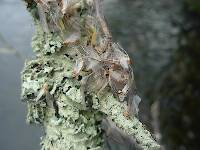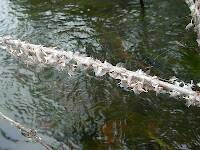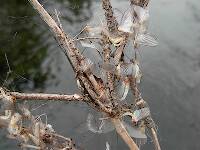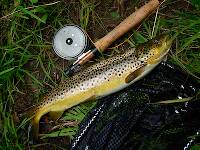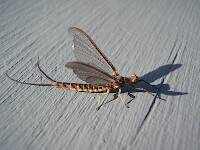
Blue-winged Olives
Baetis
Tiny Baetis mayflies are perhaps the most commonly encountered and imitated by anglers on all American trout streams due to their great abundance, widespread distribution, and trout-friendly emergence habits.
Featured on the forum
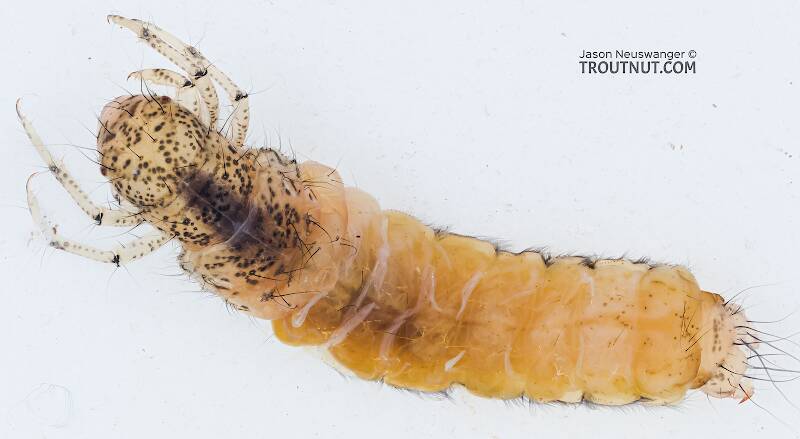
This is a striking caddis larva with an interesting color pattern on the head. Here are some characteristics I was able to see under the microscope, but could not easily expose for a picture:
- The prosternal horn is present.
- The mandible is clearly toothed, not formed into a uniform scraper blade.
- The seems to be only 2 major setae on the ventral edge of the hind femur.
- Chloride epithelia seem to be absent from the dorsal side of any abdominal segments.
Based on these characteristics and the ones more easily visible from the pictures, this seems to be Grammotaulius. The key's description of the case is spot-on: "Case cylindrical, made of longitudinally arranged sedge or similar leaves," as is the description of the markings on the head, "Dorsum of head light brownish yellow with numerous discrete, small, dark spots." The spot pattern on the head is a very good match to figure 19.312 of Merritt R.W., Cummins, K.W., and Berg, M.B. (2019). The species ID is based on Grammotaulius betteni being the only species of this genus known in Washington state.
- The prosternal horn is present.
- The mandible is clearly toothed, not formed into a uniform scraper blade.
- The seems to be only 2 major setae on the ventral edge of the hind femur.
- Chloride epithelia seem to be absent from the dorsal side of any abdominal segments.
Based on these characteristics and the ones more easily visible from the pictures, this seems to be Grammotaulius. The key's description of the case is spot-on: "Case cylindrical, made of longitudinally arranged sedge or similar leaves," as is the description of the markings on the head, "Dorsum of head light brownish yellow with numerous discrete, small, dark spots." The spot pattern on the head is a very good match to figure 19.312 of Merritt R.W., Cummins, K.W., and Berg, M.B. (2019). The species ID is based on Grammotaulius betteni being the only species of this genus known in Washington state.

Troutnut is a project started in 2003 by salmonid ecologist Jason "Troutnut" Neuswanger to help anglers and
fly tyers unabashedly embrace the entomological side of the sport. Learn more about Troutnut or
support the project for an enhanced experience here.
Millcreek on Apr 4, 2016April 4th, 2016, 6:09 am EDT
Thought some folks might be interested in this. http://news.nationalgeographic.com/2016/04/160403-mayflies-swarms-insects-bugs-spain/?google_editors_picks=true
"If we knew what it was we were doing, it would not be called research, would it?"
-Albert Einstein
-Albert Einstein
Jmd123 on Apr 4, 2016April 4th, 2016, 10:44 am EDT
HEX HATCH!!! Looks like one anyways... I wonder what genus and species that is?
Jonathon
Jonathon
No matter how big the one you just caught is, there's always a bigger one out there somewhere...
Crepuscular on Apr 4, 2016April 4th, 2016, 10:54 am EDT
looks like Ephoron sp (Polymitarcyidae) to me.
Taxon on Apr 4, 2016April 4th, 2016, 11:55 am EDT
looks like Ephoron sp (Polymitarcyidae) to me.
Ephoron virgo. Interestingly (to me at least), this is the genus of (winged lifestages) mayflies which has either (2) tails or (3) tails, depending on whether male or female.
Millcreek on Apr 4, 2016April 4th, 2016, 1:02 pm EDT
Roger -
Do all Polymitarcyidae have 2 or 3 tails? Also which sex has 2 tails and which sex has 3 tails?
Just curious,
Mark
Interestingly (to me at least), this is the genus of (winged lifestages) mayflies which has either (2) tails or (3) tails, depending on whether male or female.
Do all Polymitarcyidae have 2 or 3 tails? Also which sex has 2 tails and which sex has 3 tails?
Just curious,
Mark
"If we knew what it was we were doing, it would not be called research, would it?"
-Albert Einstein
-Albert Einstein
Taxon on Apr 4, 2016April 4th, 2016, 11:19 pm EDT
Roger -
Do all Polymitarcyidae have 2 or 3 tails? Also which sex has 2 tails and which sex has 3 tails?
Just curious,
Mark
Hi Mark-
The N. American species of family Polymitarcyidae are as follows:
Campsurus cuspidatus
Campsurus decoloratus
Ephoron album
Ephoron leukon
Tortopsis primus
Tortopsis puella
Tortopus circumfluus
It is my belief that only genus where winged males have (2) tails, and winged females have (3) tails is Ephoron, and the other three genera all have only (2) tails, independent of sex.
Crepuscular on Apr 5, 2016April 5th, 2016, 4:20 am EDT
Taxon on Apr 5, 2016April 5th, 2016, 5:15 am EDT
Yes, I'd say so, Eric. :-)
Millcreek on Apr 5, 2016April 5th, 2016, 7:03 am EDT
Roger-
Thanks for the answer.
Eric-
Just the occasional one, huh?:)
Thanks for the answer.
Eric-
Just the occasional one, huh?:)
"If we knew what it was we were doing, it would not be called research, would it?"
-Albert Einstein
-Albert Einstein
Quick Reply
Related Discussions
Topic
Replies
Last Reply
2
Jul 9, 2018
by Martinlf
by Martinlf
5
Aug 7, 2007
by Wiflyfisher
by Wiflyfisher
1
Sep 9, 2008
by GONZO
by GONZO
3
Dec 9, 2009
by Martinlf
by Martinlf
2
Mar 26, 2008
by Isidro
by Isidro
2
Sep 24, 2006
by Troutnut
by Troutnut
13
Jun 13, 2012
by Brookyman
by Brookyman






